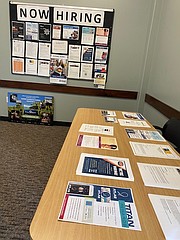It's a seller's market with labor

Samuel Wolkenhauer, a labor economist for the Idaho Department of Labor, discusses the extreme labor shortage seen currently in Kootenai County.
It's not just the scorching outside temperature.
Want a job? The market's hot, hot, hot.
“If you’re looking for work, you’ve really never had more options,” said Samuel Wolkenhauer, an economist for the Idaho Department of Labor in Post Falls.
Workers have a bounty of choices. There are 27,000 unemployed people in the state but more than twice that number of jobs available.
But there's also a caveat. You do have to live somewhere.
With the glut of available jobs comes a paucity of places to reside, and those are going for prices rising faster than the outside mercury.
Thinking in terms of a buyer's or seller's market also applies when discussing the local labor shortage, Wolkenhauer said. Whenever there's a lack of anything, he said, someone usually ends up with the short end of the stick.
“With housing and labor it’s the same deal,” he said. “Right now it’s also a seller's market with labor.”
Employers have to make the right moves to attract the best employees, or in some cases, any at all.
That means increased wages, spontaneous wage increases, sign-on bonuses, increased benefits packages and a more appealing work environment, he said.
It also means that employers have to act fast — respond to applicants more quickly, interview more immediately and hire before someone else does.
“I mostly live in the world of wage numbers,” Wolkenhauer said when asked how employees are changing to attract workers. He said creativity can really pay in landing good employees.
“Pet insurance, veterinary insurance is one innovative way to beef up compensation,” he said.
Wolkenhauer said the labor shortage has been trending since the start of 2021 and won’t likely change anytime soon. What people forget, he said, is that before the COVID-19 pandemic changed our focus, the labor market was very tight; the labor economy was already moving in this direction.
The month before COVID hit, Kootenai County was seeing an all time low for unemployment. The very next month, we were at an all time high, Wolkenhauer said.
Wolkenhauer expects to see wages continue to increase, which will in turn raise costs of services and goods. Some small businesses may struggle to compete.
“It’s kind of like playing a game of musical chairs,” he said. “Somebody is going to be left without their positions being filled."
Many believe the boost in unemployment benefits is to blame, that people are choosing not to work because benefits are so high.
For the week ending July 3, there were only 393 unemployment claims filed in Kootenai County. According to the Idaho Department of Labor, the average benefit amount in 2020 was about $277 weekly and has increased this year just $10, to $287.
Temporary additional benefits were in place during the pandemic. Those have all stopped for Idaho residents. Gov. Brad Little made the discontinuation effective June 19.
The federal Pandemic Unemployment Compensation benefit had provided an extra $300 weekly, the Pandemic Unemployment Assistance benefit offered unemployment to the self-employed, and the Pandemic Emergency Unemployment Compensation package, which extended benefits once exhausted, have all been discontinued.
Labor economists will closely be watching the “quit rate,” Wolkenhauer said. Workers quit undesirable jobs when they know they have leverage and can easily secure new employment.
“We’re at an all time high for the number of quits,” Wolkenhauer said. ”And that’s a really good sign that workers know they have options.”
Entering the foyer of the labor department, visitors are greeted with bulletin boards and tables lined with employment opportunities. A Humanix representative was on site July 12 to speak with candidates immediately. Job fairs are conducted regularly.
Using the abundance of employment options to one’s advantage is something Wolkenhauer readily endorses. These employment conditions offer an opportunity for workers to make income gains, he said, to improve their lives and flourish.
“In the last 20 to 30 years,” Wolkenhauer said, "it’s never been a more favorable market for a job seeker.”












